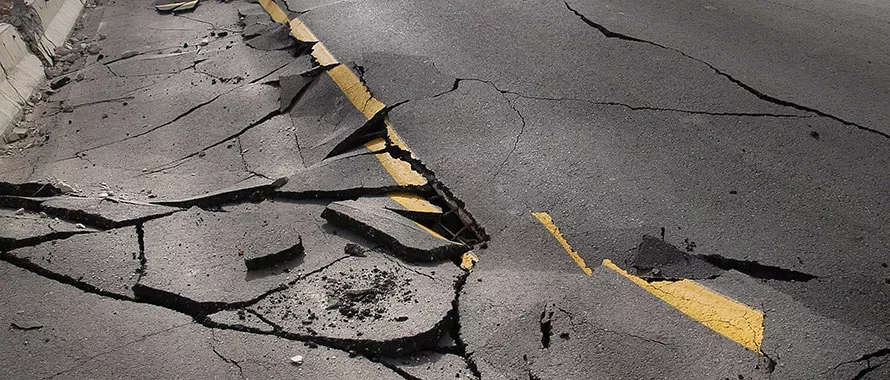A new report from the U.S. Geological Survey (USGS) indicates that the economic toll of earthquakes has reached an estimated $14.7 billion in total annualized building damages and associated losses. That figure is double previous estimates and accounts for higher property values, building improvements and other factors, Property Casualty 360 recently reported.
Featured Solutions
“It is pretty eye-opening to see how much of a potential loss really is possible from earthquakes,” said Brandon Hunter, Associate Managing Director, Underwriter, Commercial Insurance, Burns & Wilcox, Indianapolis, Indiana. “That number was higher than anticipated, but it makes sense when you look at some of the factors like valuations increasing by quite a bit and the financial impact of those consequential losses that are included. Those things can really add up.”

It is pretty eye-opening to see how much of a potential loss really is possible from earthquakes.
Calculating the potential cost of earthquakes can help inform mitigation efforts such as retrofitting vulnerable buildings to updated codes and funding projects to improve earthquake resilience, FEMA and the USGS noted. Today, many property owners are at risk for earthquake damage and may not have coverage for these losses under their Homeowners Insurance or Commercial Property Insurance.
“The potential loss is catastrophic,” said Mark Wightman, Director, Personal Insurance, Burns & Wilcox, Salt Lake City, Utah. “Earthquakes are never part of a basic Homeowners Insurance policy. Sometimes homeowners can find an endorsement, but most of the time they are going to have to find a separate policy.”
Large earthquakes rare, but devastating
Earthquakes are considered one of the most devastating types of natural disasters, accounting for just 8% of global natural disaster occurrences between 2000 to 2019 but 58% of total deaths in that timeframe, according to the Center for Disaster Philanthropy. They can also cause extensive damage to infrastructure. Earthquakes that hit Türkiye and Syria on Feb. 6 caused an estimated $5.1 billion in direct physical damages in Syria, according to a World Bank Global Rapid Assessment report released March 3. That figure does not include broader economic impacts, which are an important consideration, Hunter said.
“The areas where earthquakes are prone to occur are some of the most populated areas,” Hunter said. “Because of that, you have a lot of buildings and structures very close together and then there is damage after the fact from downed power lines and a variety of other factors that also make it very devastating.”
While all U.S. states have some potential for earthquake shaking, the risk is highest along the West Coast, the Intermountain West, and in some parts of the Central and Eastern U.S., according to the USGS. Alaska and California experience the most earthquakes, while California has more damage-inflicting earthquakes than any other state. Earthquakes also occur across much of Canada, according to Natural Resources Canada; Western Canada is at the greatest risk, with over 100 earthquakes of magnitude 5 or greater occurring in the offshore region west of Vancouver Island alone over the past 70 years.
In the U.S., “the West Coast is probably the most exposed” as far as potential damages, Wightman said. According to FEMA, 67% of the country’s annual earthquake losses in 2017 were in California and 73% were concentrated between California, Oregon and Washington.
Since earthquakes are not typically covered on standard Homeowners Insurance and Commercial Property Insurance policies, most property owners need to seek out separate Earthquake Insurance to cover earthquake-related property damage, Wightman said. Many homeowners go without coverage, however. In California, only about 10% of residents carry Earthquake Insurance, according to FEMA. Insurance uptake may be higher in some areas of Canada, with one study showing that in the same Pacific Northwest region, over 60% of homeowners in Canada purchased the coverage compared to less than 14% of those in Washington State, Insurance Business Magazine reported in 2021.
“For anybody in those earthquake-prone areas, I would offer that coverage because of the potential of a catastrophic loss,” Wightman said. “In California, it is required by the state that Earthquake Insurance is offered with every policy; that is not the case in other Western states, so homeowners may not be as aware of it.”
Beyond rebuilding costs, business owners who do not add earthquake coverage to their Commercial Property Insurance or seek out standalone Earthquake Insurance could face additional losses if they are temporarily unable to operate, Hunter said. “It is not a standard covered peril on a commercial policy. If your business is not insured for an earthquake and there is an earthquake-related loss, you may not have the funds to get back up and running,” he said, pointing out the importance of business interruption coverage. “What often happens is that an uninsured loss would force the business to close versus being able to eventually reopen.”
Retrofits, rebuilds can help mitigate losses
As the economic threat of earthquakes increases, “it is getting harder to get earthquake coverage for both personal and commercial properties,” Hunter said. “A lot of insurance carriers have seen the large risk of earthquakes and are trying to lessen their exposure.”
Soaring rebuilding costs have also had an impact, increasing the cost of potential earthquake-related losses and making property owners at higher risk of being underinsured, Wightman said. U.S. construction costs rose 17.5% between 2020 and 2021, NBC reported last year, and residential construction costs in Canada increased over 20% between 2021 and 2022, according to Statistics Canada.
“On any Homeowners Insurance policy, you need to look at the cost to rebuild your home — the replacement cost of your home. That is what you are insuring your house for,” Wightman said. “Building materials, as we all know, have really been hurt by inflation, along with labor costs. Reviewing and updating the value of your home is a really important thing, regardless of whether it is regular Homeowners Insurance or an earthquake policy.”
While earthquakes are a more challenging risk to mitigate, there are steps property owners can take to reduce the impact of a loss, Hunter said. This can include adding earthquake strapping and reinforcing foundations. “When there is a large earthquake, the damage is pretty severe,” he said. “With a lot of older homes, and especially concrete-construction homes or buildings, retrofitting can help turn what would be a devastating loss into something more minimal. It is still not something that you can really prevent like some other risks.”
In many areas at higher risk for earthquakes, there has been a push among municipalities and private owners to retrofit or even rebuild higher-risk structures. In Salt Lake City, Utah, The Church of Jesus Christ of Latter-day Saints has been working on a seismic upgrade project to make its historic temple more stable in the event of an earthquake, KSL reported last year. The massive project, the cost of which has not been disclosed, is expected to be completed in 2025, the Salt Lake Tribune reported.
“There is also a big movement in Utah to rebuild schools built in the 20th century because they are not as earthquake-safe,” Wightman said. “There has definitely been a push in the last 15 or 20 years to review some of these structures, especially the public buildings.”
Similar efforts have been taken on in California, Hunter noted. “It is also really big there,” he said. The cost of these renovations would not be covered by insurance, Wightman added, and “sometimes even retrofitting for earthquakes is going to be more expensive than rebuilding.”
‘Always ask’ about earthquake coverage
Homeowners who are unsure about their insurance coverage for earthquake damage should discuss it with their insurance broker, keeping in mind that older homes made with brick that is not reinforced will be more difficult to insure. “If you have a solid brick home that was built before 1950, it is probably not reinforced,” Wightman said, noting that consideration should be given to any portions of brick on a home, such as the chimney. “Anything that has masonry is not as flexible as a frame home. If there is steel involved in a commercial building, there is reinforcement, and that is going to bend with the earthquake. With brick, you want to make sure that the brick portion of that home is covered — not just for the replacement of the brick but also the damage done by the falling brick.”
Homeowners should know that standalone Earthquake Insurance policies generally come with a deductible of between 5% to 15% — still a considerable amount for many property owners, Wightman said. “If you are looking at an Earthquake Insurance policy on a $400,000 home, with 10% you are going to have to come up with $40,000,” he said. “Compared to $400,000, $40,000 is probably worth it.”
For homeowners, Earthquake Insurance generally only includes property damage and would not cover third-party bodily injuries. “These policies are not going to have any kind of liability on them; it is just for the damage to the property,” Wightman said.
Even as some insurance carriers pull back on earthquake coverage, “options are out there for standalone Earthquake Insurance,” Hunter emphasized. “For larger commercial properties, you can also get Excess Earthquake Insurance over whatever limits you have on your policy.”

Do not just assume that you have the [insurance] coverage, that you cannot have it, or that you are not at risk.
Availability ultimately depends on where the property is located, Hunter said, and “there are certain areas in California or along the New Madrid Fault line where coverage may be harder to get because of the risk factors being higher.”
For homeowners and business owners alike, the risk of earthquake damage should not be overlooked. “If they are close to or on that fringe of being near a fault line, it is definitely something they should check into,” said Hunter, encouraging individuals to utilize modeling maps and other resources to get a better sense of their risk. “A lot of faults are there that can still cause a lot of damage. A lot of times, the peace of mind is worth the small expense when it comes to some of these areas for earthquake coverage. If they are not sure, they should always ask those questions to their insurance broker. Do not just assume that you have the coverage, that you cannot have it, or that you are not at risk.”





